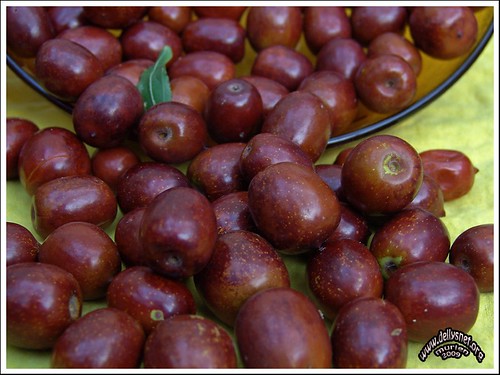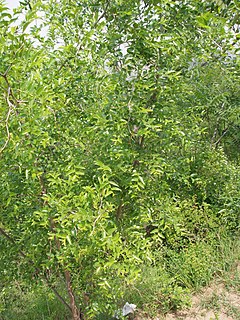
![]() All rights reserved by murien
All rights reserved by murien
I was sure some of you would be interested in this article form the previous comments I have had, so for my first in a series of Italy Bloggers' on Friday Feature this week I would like to introduce you to Rowena... and here is what she had to say along with her link to the relevant post on the jujube.
Rowena... said...
You have giuggiole (jujube)? What luck! Three years ago we went to the Festa della Giuggiole in Arquà Petrarca (Veneto) and had a lot of fun. I've wrote about the festa and some other pertinent info (they even had a jujube gelato stand - yum). Antonella Clerici even did a cooking experiment on her show. What fond memories, and 2010's festa should be happening around this time of year again. Here's the url of my post in case you or any or your readers might be interested:
http://rubbahslippahsinitaly.blogspot.com/2007/10/festa-delle-giuggiole.html

Unfortunately I forgot to take a picture of one of our trees before it lost its leaves for this year but I found the photograph above on the Wikipedia - Jujube page for the fruit.


Jujube in our Garden last month.
The jujube certainly has an interesting flavour as it tastes a little bit like an apple but I understand how it is also known as a Chinese Date as there is definitely a hint of the flavour and sweetness that you get from a date as well. Extensively cultivated in southern Asia, it seems likely it was introduced to south-eastern Europe many years ago. It is a small deciduous tree and grows around 5-10 metres in height, not very user friendly for harvesting as the branches are thorny. When I first saw these fruits I thought they were a different sort of olive as they are similar in size and the single hard stone is also like that of an olive!
The tree tolerates a wide range of temperatures and rainfall, though it requires hot summers and sufficient water for acceptable fruiting. Unlike most of the other species in the genus, it tolerates fairly cold winters, surviving temperatures down to about −15°C. This enables the jujube to grow in desert habitats, provided there is access to underground water through the summer. Virtually no temperature seems to be too high in summertime.
Apart from eating these unusual little fruits as snacks it seems they are used in Asia in traditional medicine, stress and sore throats are mentioned. Jujube juices and teas are also produced and in China even a wine, it seems that in Asia there is in fact a wide variety of uses. We did not produce many this year, only enough to enjoy as a little nibble for a few weeks.
Who knows what next year may see us doing with them, now I have discovered all this extra information, gelato anyone, thanks to Rowena's blog and Wikipedia.
I also discovered that The Oxford Diner’s Dictionary, Food and Drink from A to Z, of which a copy lives in my kitchen, has an entry for the Jujube which I felt worth reproducing here in full.
“Although now little heard of, the jujube was common in the nineteenth and early twentieth centuries as a fruit-flavoured gum or lozenge, often medicated to allay coughing. The first account of it in print comes in Peter Simmonds Dictionary of Trade Products (1858): ‘The term jujube is very generally applied by chemists and confectioners to a thickened mucilaginous lozenge’ However, this was merely a secondary application of the term, which originally denoted an edible berrylike fruit of a tree of the buckthorn family ( the word jujube is a corruption of its original Greek name zizyphon). The fruit, which has a red skin and sweet yellowish flesh, was perhaps used to flavour the lozenges which became know as jujubes; or alternatively the transfer of names may have been based on a similarity of shape.”
Well there you go, certainly until recently I had only ever know jujubes as a type of lozenge certainly not as a fruit I would be eating from my own garden in Italy!
I also only know jujubes as I type of lozenge. I really have never heard of them. When I first saw the photoes, I thought it was an olive. Very interesting. (Wonder if they have any health-giving qualities?!).
ReplyDeleteA new one to me! How fun to learn about food and practices and other bloggers. What a great world we live in!
ReplyDeleteI just adore your slideshow widget, btw!
Fascinating. Maybe someday I will have the pleasure of tasting one.
ReplyDeleteI have never heard of them before! It is like our Medlar tree that I had never heard of before we had one. Interesting how many fruits there out there that are unknown to us. Diane
ReplyDeleteI never tasted giuggiole, however to stay in an Idiom mood, andare in brodo di giuggiole (to go jujube broth) means to be tickled pink ;)
ReplyDeleteA new one for me also. See I am learning a lot already and have been following for only a few days! Have a lovely weekend. hugs♥olive
ReplyDeleteThis is so interesting..I have never heard of this type of fruit..How wonderful to have it in your yard/garden. I bet it is full of vitamin C.and helps with healing colds. What fun you are having. Picking all kinds of fruit/making wine..
ReplyDeleteHow great to enjoy all these wonderful gifts..right in your own yard..
Have a happy weekend..
Thisisme - When we moved here last year, they were new to us and we also thought they were a different type of olive. According to Wikipedia, they may help reduce stress.
ReplyDeleteLakeviewer - So while on line we are educating ourselves great excuse. thanks for the comment on the slideshow widget, good to know someone likes it besides me.
Unknown Mami - I hope so :)
Food,Fun - Diane, it is interesting all these new tastes to experience.
Alessandra - I am tickled pink by the latest idiom :)
Olive - Reading blogs from around the world is such a fun way of learning :)
Rosebud - I believe it does, hope so as eating one a day in case they help ward away colds this winter. Yes we are truly blessed with produce in this garden.
Your garden is so generous!!! Love giuggiole and their funny name!
ReplyDeleteHave a wonderful week end!
Vale
Jujubes show up at this time of year at the farmer's markets in California (think Mediterranean climate!) and I have never had a clue what to do with them.
ReplyDeleteYummy! I love giuggiole (here in Veneto called "zizoe")! They remind me my chilhood.
ReplyDeleteI tasted them for the first time this fall...in Arquà Petrarcha in fact. I bought two pomegranates from a fruit stand near Petrach's house and the vendor threw in a small bag of these as well. I'm glad to know more about them!
ReplyDeleteThat sounds absolutely fascinating! I must find myself a specimen to plant on our land.
ReplyDeleteThank you for spreading the word about this curious fruit! (btw, just in case it wasn't a typo, I'm in Lecco up north, not Lecce). Sadly jujube doesn't end up in our supermarkets when it's in season. This could be just because there's not enough to ship around the country or because a lot of people still don't know about it, hence the lack of demand.
ReplyDeleteLes Cotrions -Despite the weather we have had a relaxing BH weekend. I have trouble saying it as well which doesn't help!
ReplyDeletePatricia - Will you be trying some now? Let me know what you think if you do.
Dona - Another funny name, I would have trouble pronouncing.
SomeBirds - You did not say if you liked them though?
Heiko - Welcome and thanks for commenting, they seem to grow very freely around here and we have just moved two small ones that seem to have seeded themselves to another part of the garden. So you might find someone willing to give you one for your land.
Rowena - A pleasure and it gave me an excuse to feature you :) Sorry about the typo which I corrected. Let's hope we can help just a little in the introduction of this little fruit to others.